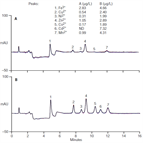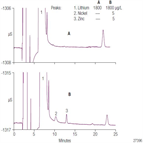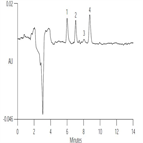Find methods for your needs
Refine by Feature
Displaying 1-5 of 6 results for Tag: Zinc
AU168: Determination of Transition Metals in Complex Matrices
Instrument Type: ICChelation ion chromatography facilitates the determination of low concentrations (μg/L and lower) of transition metals in samples including seawater, brines, estuarine waters, and a variety of biological samples. Here, the authors simplify the system configuration described in Technical Note 25, using an ICS-3000 system. The separation has also been updated to include the IonPac CS5A/CG5A column set, which demonstrates improved selectivity and peak efficiency for separation of transition metals compared to the CS5.
AN108:Determination of Transition Metals in Serum and Whole Blood by Ion Chromatography
Instrument Type: ICThe determination of transition metals in physiological fluids is of considerable interest in clinical chemistry. This application note describes an attractive alternative to traditional spectroscopic methods by using the principles of ion exchange. Separation between individual metals can be enhanced or altered simply by changing eluents (pyridine-2, 6-dicarboxylic acid or oxalic acid). This figure illustrates the selectivity on an IonPac CS5A column when using a pyridine-2, 6-dicarboxylic acid eluent.
AN250: Determination of Trace Nickel and Zinc in Borated Power Plant Waters Containing Lithium Hydroxide Using Nonsuppressed Conductivity Detection
Instrument Type: ICBoron as boric acid is used to control the nuclear reaction in pressurized water reactors (PWR) because of its strong neutron-absorbing characteristics. In addition, lithium is added to adjust the pH and zinc is added to suppress cobalt (58Co, 60Co) activity. Dissolved Ni in these solutions can be indicator of stress corrosion. To minimize corrosion, Ni and Zn monitoring is needed. Here µg/L of Ni and Zn in borated lithium water samples are determined on IonPac SCS-1 column and detected by non-suppressed conductivity. We recommend AN277 if sub-ppb detection is needed.
AN131: Determination of Transition Metals at PPT Levels in High-Purity Water and SC2 (D-clean) Baths
Instrument Type: ICSemiconductor cleaning solutions used to remove potentially damaging transition metal contamination are monitored to assess cleaning efficiency. Here trace concentrations (ng/L) of transition metals in semiconductor cleaning solutions and deionized water are separated using the strong complexing agent, pyridine-2,6-dicarboxylic acid (PDCA), on an IonPac CS5A column optimized with anion- and cation-exchange chemistry. Then a post-column derivitization agent, 4-(2- pyridilazo)resorcinol (PAR), is added to displace PDCA and to facilitate detection at 520–530 nm.
AN286: Determination of Trace Copper, Nickel, and Zinc in Boiling Water Reactors Using Nonsuppressed Conductivity Detection
Instrument Type: ICThis work describes the determination of trace concentrations of copper, nickel, and zinc in a boiling water reactor (BWR) matrix (i.e., deionized water) by cation-exchange chromatography using a 2 mm Thermo Scientific Dionex IonPac SCS 1 column and nonsuppressed conductivity detection. A Thermo Scientific Dionex Ultralow Pressure Trace Cation Concentrator (TCC-ULP1) column is used to concentrate 8 mL of sample, which enables detection limits of <0.2 μg/L for copper, nickel, and zinc.





